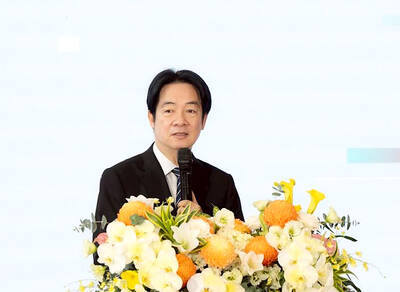Next month has been designated “national unity month” to boost civilian preparedness and emergency response measures, with urban resilience drills to be held across Taiwan, a national security official said yesterday.
President William Lai (賴清德) is to preside over the fourth meeting of the Whole-of-Society Defense Resilience Committee on Thursday, where he would declare next month as “national unity month,” said the official, who wished to remain anonymous.
With the slogan “Team Taiwan, Stronger Together,” the core principle of “national unity month” is that defense is not the sole responsibility of the military, but a duty shared by all citizens, the official said.

Photo courtesy of the Presidential Office
The military and civilians would work together to demonstrate national unity, showing the world Taiwan’s resilience and strong will to defend and protect itself, they said.
Urban resilience exercises would be held across northern, central and southern Taiwan, with each city and county to host civil defense drills, including air raid response drills, they added.
The exercises would run alongside the Han Kuang exercises, Taiwan’s largest annual military drills, which have been extended to 10 days this year, up from five.
From Wednesday next week to July 31, the Ministry of the Interior and the National Police Agency would host air raid shelter exhibitions with educational displays and emergency preparation kits, the official said, adding that an exhibition would be held in Taipei’s Ximen (西門) MRT Station.
The ministry would also release a new edition of the air defense shelter guide on Wednesday next week, along with an app to help people locate their nearest shelters, they said.
“National unity month” is to begin with air raid alert drills, incorporating emergency medical stations and relief centers, and would be hosted by all 22 local governments in coordination with the Han Kuang exercises, the official said.
The urban resilience drills would be condensed into a single day, testing several scenarios, emergency response systems, and cooperation between military and civilian agencies, including intelligence sharing, they said.
The National Land Management Agency is incorporating air raid shelters into public safety inspections starting this year, they added.
Full-scale evacuation drills would be held in Taipei’s Zhongzheng (中正), Zhongshan (中山) and Songshan (松山) districts, Taichung’s Shalu (沙鹿), Cingshuei (清水) and Wuci (梧棲) districts, and Tainan’s West Central (中西), East (東) and Shanhua (善化) districts, the ministry said.
All residents in the nine districts would participate in drills led by civil defense teams, village wardens, volunteer police officers, firefighters and community organizations, such as building management committees.
Locations such as public parking lots, government buildings and apartment complexes would be required to open their doors as shelters, helping the public to practice air raid procedures, the ministry said.
The drills are being held with the aim of discouraging people from waiting out alerts at convenience stores during the annual Wanan air defense exercise, national security officials said.

MISINFORMATION: The generated content tends to adopt China’s official stance, such as ‘Taiwan is currently governed by the Chinese central government,’ the NSB said Five China-developed artificial intelligence (AI) language models exhibit cybersecurity risks and content biases, an inspection conducted by the National Security Bureau (NSB) showed. The five AI tools are: DeepSeek, Doubao (豆包), Yiyan (文心一言), Tongyi (通義千問) and Yuanbao (騰訊元寶), the bureau said, advising people to remain vigilant to protect personal data privacy and corporate business secrets. The NSB said it, in accordance with the National Intelligence Services Act (國家情報工作法), has reviewed international cybersecurity reports and intelligence, and coordinated with the Ministry of Justice Investigation Bureau and the National Police Agency’s Criminal Investigation Bureau to conduct an inspection of China-made AI language

BOOST IN CONFIDENCE: The sale sends a clear message of support for Taiwan and dispels rumors that US President Donald Trump ‘sold out’ the nation, an expert said The US government on Thursday announced a possible sale to Taiwan of fighter jet parts, which was estimated to cost about US$330 million, in a move that an expert said “sends a clear message of support for Taiwan” amid fears that Washington might be wavering in its attitude toward Taipei. It was the first announcement of an arms sale to Taiwan since US President Donald Trump returned to the White House earlier this year. The proposed package includes non-standard components, spare and repair parts, consumables and accessories, as well repair and return support for the F-16, C-130 and Indigenous Defense Fighter aircraft,

CHECKING BOUNDARIES: China wants to disrupt solidarity among democracies and test their red lines, but it is instead pushing nations to become more united, an expert said The US Department of State on Friday expressed deep concern over a Chinese public security agency’s investigation into Legislator Puma Shen (沈伯洋) for “secession.” “China’s actions threaten free speech and erode norms that have underpinned the cross-strait ‘status quo’ for decades,” a US Department of State spokesperson said. The Chongqing Municipal Public Security Bureau late last month listed Shen as “wanted” and launched an investigation into alleged “secession-related” criminal activities, including his founding of the Kuma Academy, a civil defense organization that prepares people for an invasion by China. The spokesperson said that the US was “deeply concerned” about the bureau investigating Shen

‘TROUBLEMAKER’: Most countries believe that it is China — rather than Taiwan — that is undermining regional peace and stability with its coercive tactics, the president said China should restrain itself and refrain from being a troublemaker that sabotages peace and stability in the Indo-Pacific region, President William Lai (賴清德) said yesterday. Lai made the remarks after China Coast Guard vessels sailed into disputed waters off the Senkaku Islands — known as the Diaoyutai Islands (釣魚台) in Taiwan — following a remark Japanese Prime Minister Sanae Takaichi made regarding Taiwan. Takaichi during a parliamentary session on Nov. 7 said that a “Taiwan contingency” involving a Chinese naval blockade could qualify as a “survival-threatening situation” for Japan, and trigger Tokyo’s deployment of its military for defense. Asked about the escalating tensions